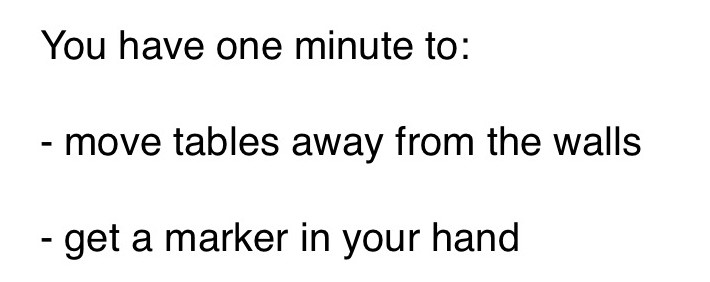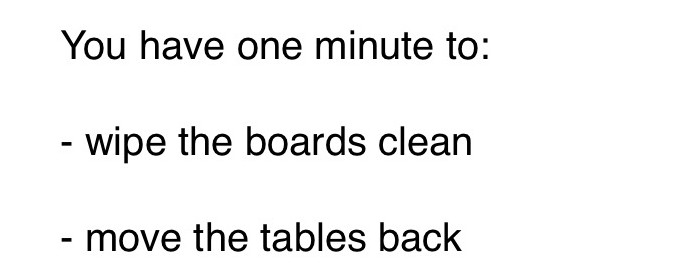
Notice: Originally published May 24, 2016 at Teaching Out Loud.
I recently presented at Learning IgnitED! That’s the name of the regular faculty workshop series offered by Dartmouth’s Educational Technologies Group. In each session three or four faculty members get about 5 minutes each to present a problem that they had in their teaching and how they solved it. After everyone presents, the host moderates Q&A with faculty, staff, and interested observers. It’s informal, fast-paced, often funny, and informative.
When I presented at the first Learning IgnitED! session in Spring 2015, we held the sessions in the Dartmouth Center for the Advancement of Learning. That’s a great place for workshops and events. But now we have the Berry Innovation Classroom. It’s our flagship learning space on campus. So now that’s where we hold Learning IgnitED!
I teach in BIC, so I was glad to accept the invitation to present. Few presenters ever take advantage of Berry Innovation Classroom’s special features for a Learning IgnitED! presentation. So I determined to jam as much active learning fun into one session as possible. Here what I presented (along with my observations) after a kind introduction from Mike Goudzwaard:
TITLE: Seeing What Others See
I teach FILM7: Mass Media & Democracy, right in this room. FILM7’s a first-year seminar, so we emphasize writing, especially the writing process. How many of you have ever written anything? (all hands go up, some kind souls laugh) So you know! It’s messy, nonlinear, incomplete, ugly, even embarrassing.

In our class we make that messiness visible, so everyone sees that it’s normal. Students see and touch my work in process. Students see and touch each other’s work in process. They even see my reflections on how the class itself is working or not, which Mike and I are publicly blogging this quarter. (I point to the address of this blog on the whiteboard)

A lot of classes do things like that, of course: trading drafts, working in small groups, etc. Honestly, we know that students learn more from each other than they ever learn from us.
But what works in small groups can be hard to scale up. It’s hard to see what a lot of others are seeing, as they see it, especially when you have 15 or 30 students working on something at the same time. But in this classroom, you can do things to make it easier.
Let’s do some active learning. Ready? (Out of about 30 attendees, half look excited, half look nervous)
Before we start, note that all the furniture in the room moves around. Everything. Like this!
(At this point I jump on a table and roll across the room. Yes, for real. The number of nervous-looking people does not decrease.)
Here are your instructions.

(For one minute everyone moves around, rearranges furniture, positions themselves in front of boards with markers poised, etc)
Everybody set? Now, I’m going to project some text from Dartmouth’s website about our core values. Using your markers to write directly on the whiteboard over the projected text, you’ll circle two core values that you think deserve the most investment right now, then write your initials next to the text where you marked it up. Mark the text, sign your work. You’ll have two minutes. Questions?
(I hit the button and 7 projectors display the text on whiteboard walls spaced evenly around the room perimeter.)
Do it now. 2 minutes. (Everyone starts marking up the text projected onto the whiteboards, passing around markers, signing their work, etc. I use a stopwatch to track elapsed time.)
(2 minutes pass, I clap my hands) Okay, stop writing. All attention to center of room, please. First thing I want you to do is silently look around at what your colleagues have written. Give yourself a few seconds to spot any patterns. Similarities? Differences? Just silently look around.
(People are staying in place, more or less, so I urge them to circulate around the room. I comment that it looks like a cocktail party with no actual cocktails.)
(1 minute passes, I clap my hands) Okay, let’s report back. What did you see? Were there any surprises?
(Several responses! One person notes differences in what was selected, e.g. words vs. entire phrases. Another person notes similarities in which core values people highlighted. Someone else notes that different groups of colleagues who sat together did similar things. While we talk, everyone stands around with markers in their hands and furniture scattered all around them.)
That’s great! I think you can see how this would start useful discussions in class. And even in this brief session you’ve learned something interesting about your colleagues: what they look for, how they make choices, what they think is important.
Obviously in the classroom you could do this exercise with almost any text or image. In my class we’ve done this exercise with active/passive rewriting, reverse outlining, identifying arguments and evidence, rewriting thesis statements, etc etc etc.
But the key is visibility. Students see each other’s work, but also how they’ve done it, how far along they are while they’re doing it, and how they might do their own work differently. They see what others see. That’s huge.
And now you have to clean up, just like my students do.

Take my advice: if you teach in this room, put that slide at the end of every presentation.
(Everyone restores the room to pre-presentation conditions in one minute flat.)
Thanks for being good sports and participating in active learning!
(some applause)
Michael S. Evans
© Michael S. Evans 2008-2024